实例介绍
【实例简介】H264编解码
【实例截图】
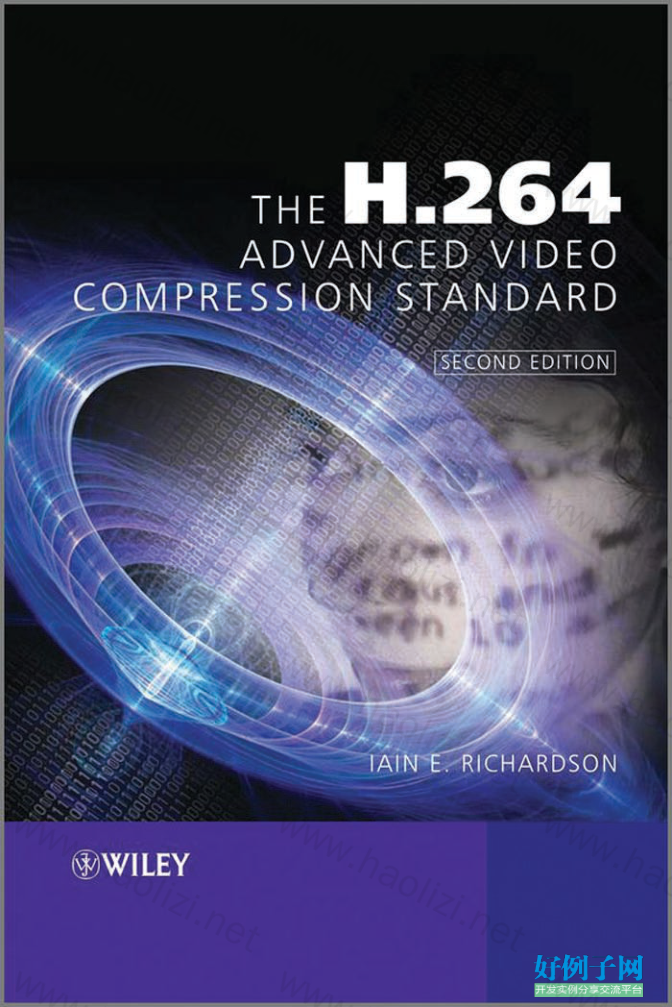
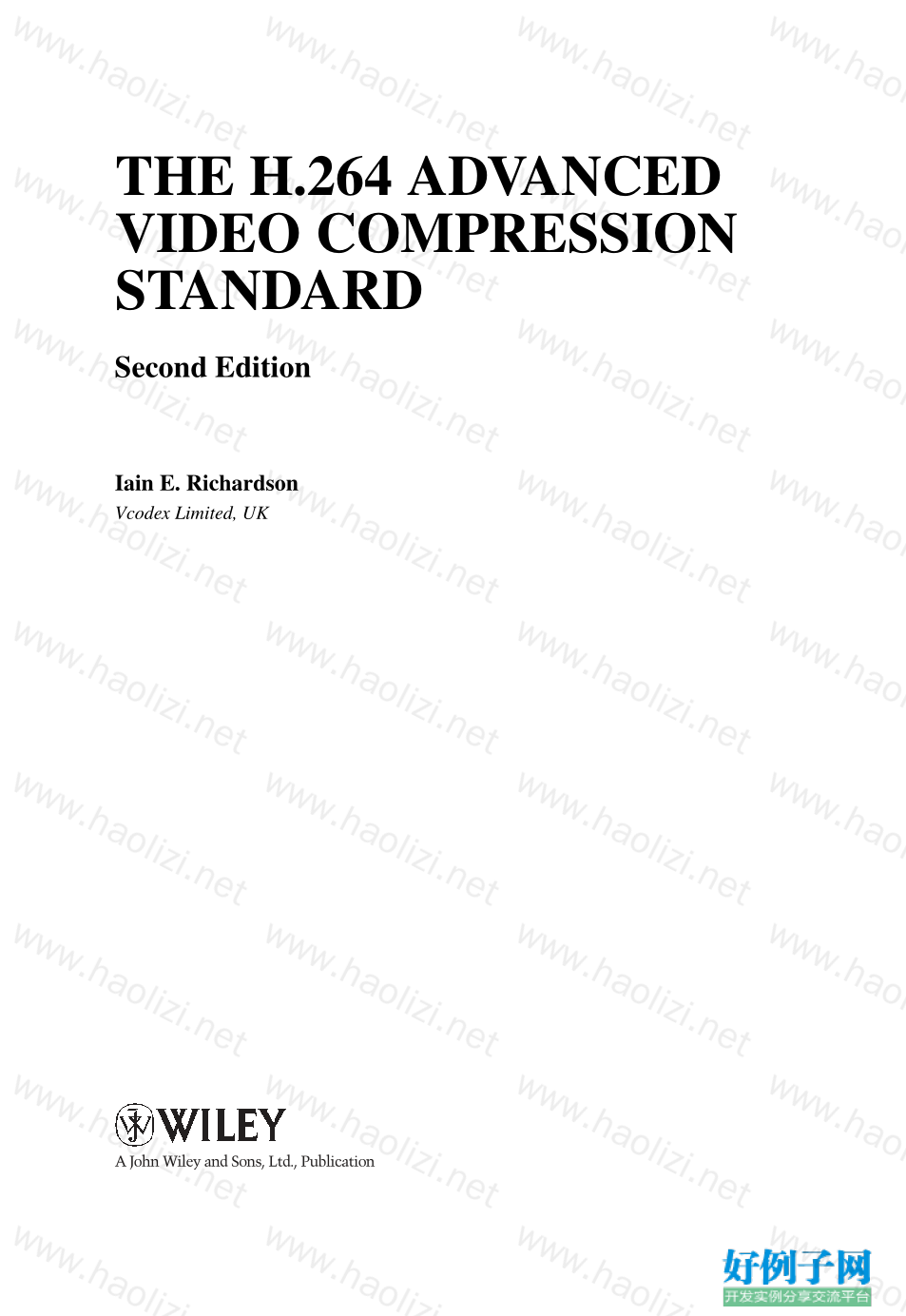
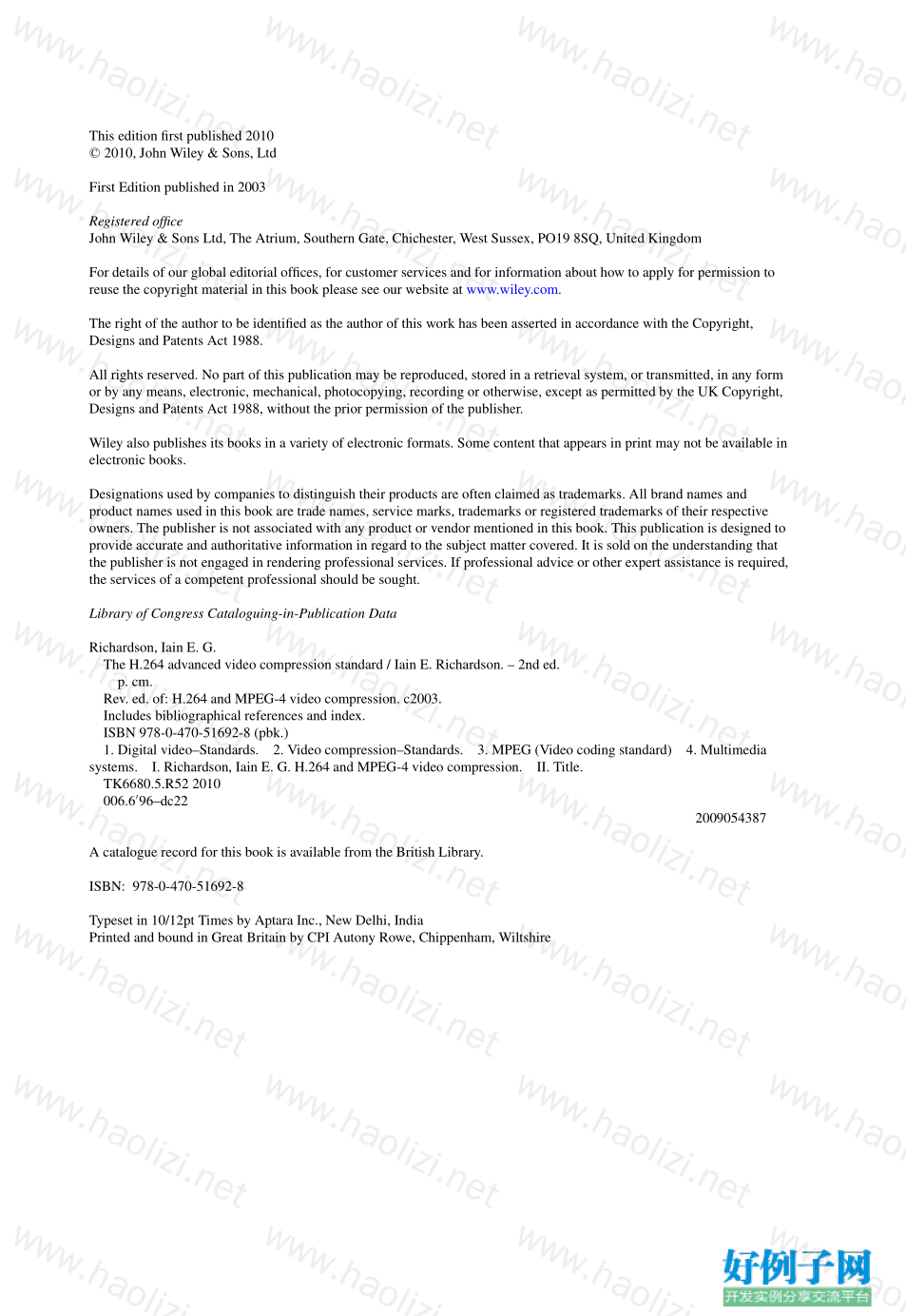

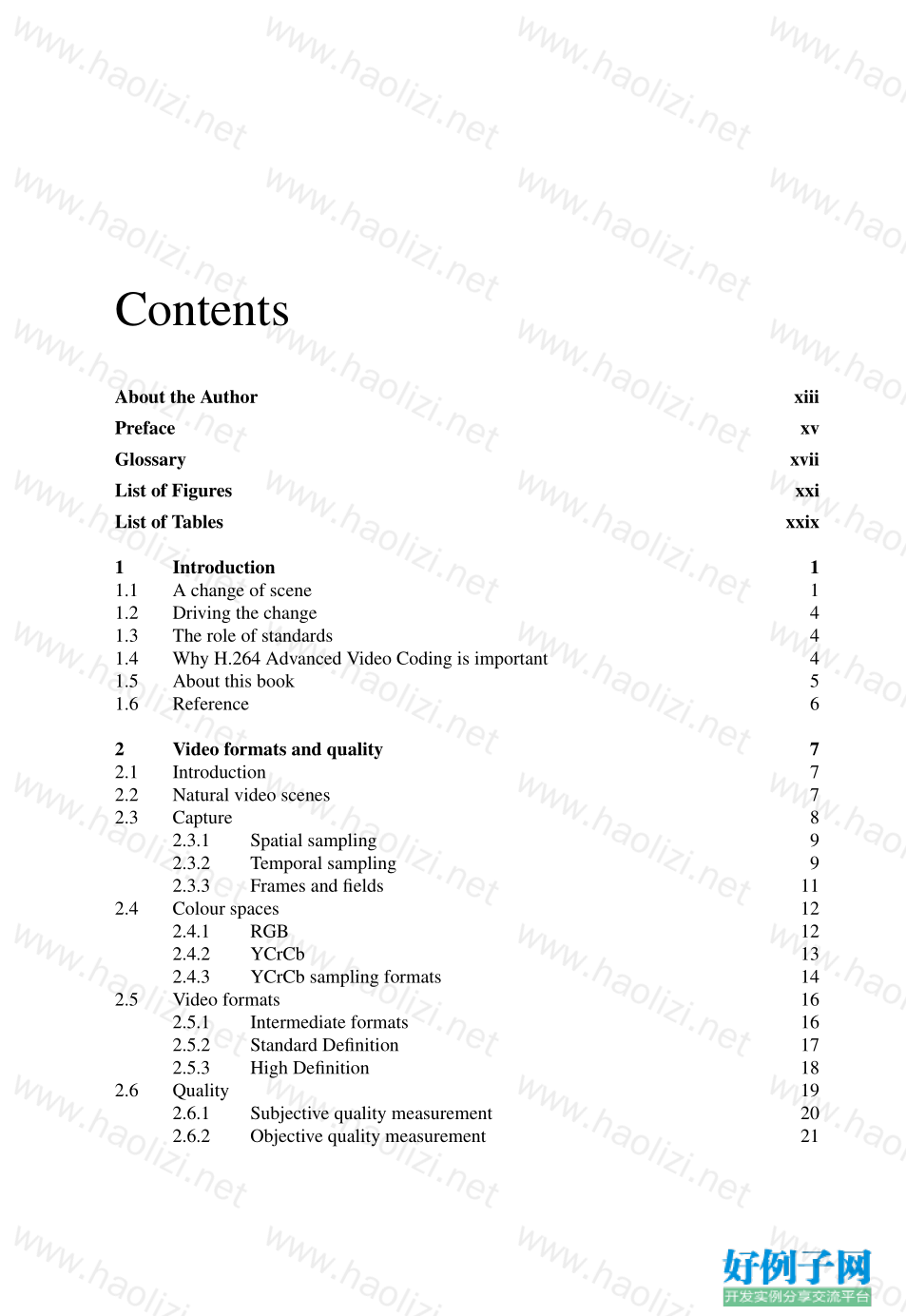
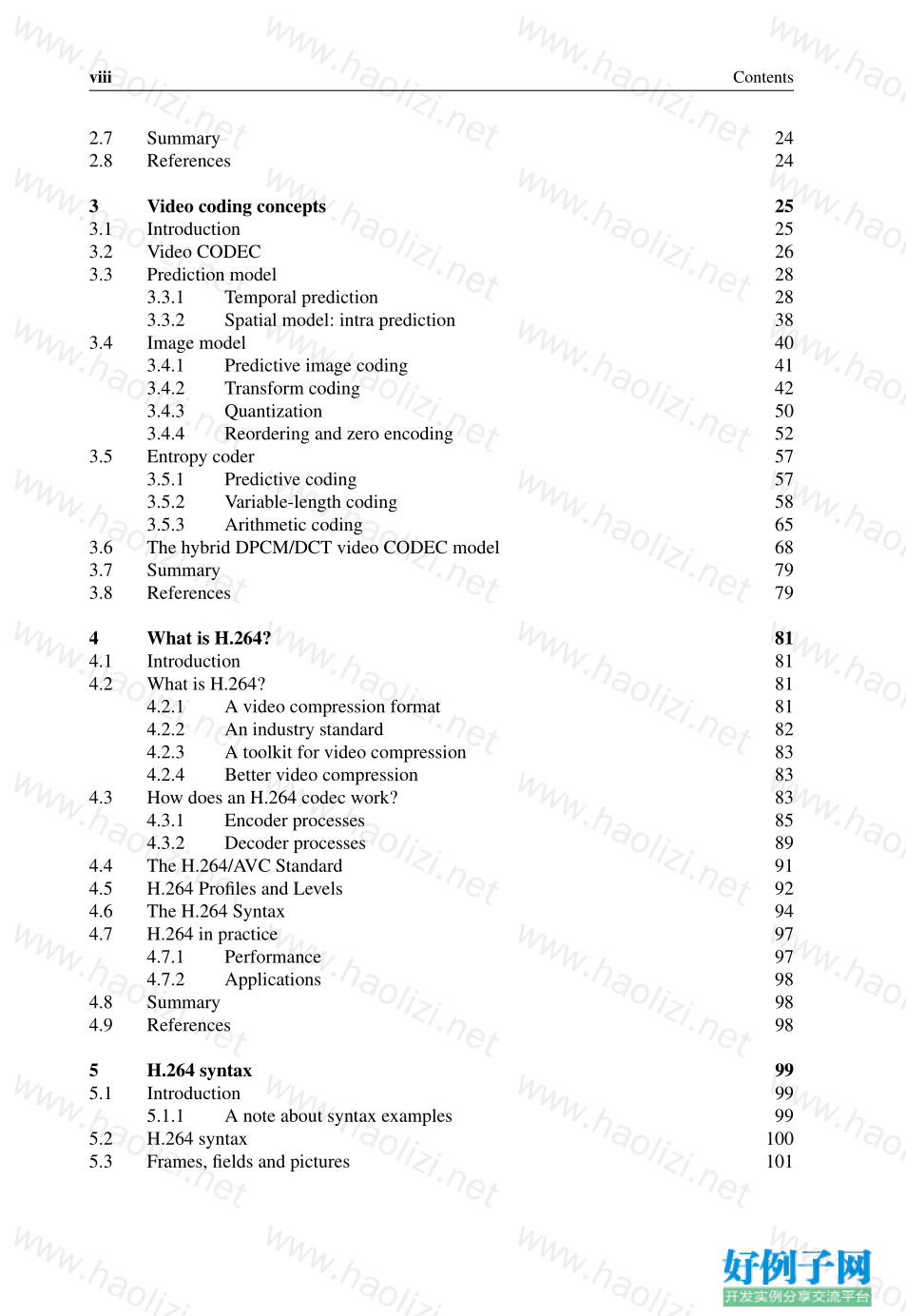
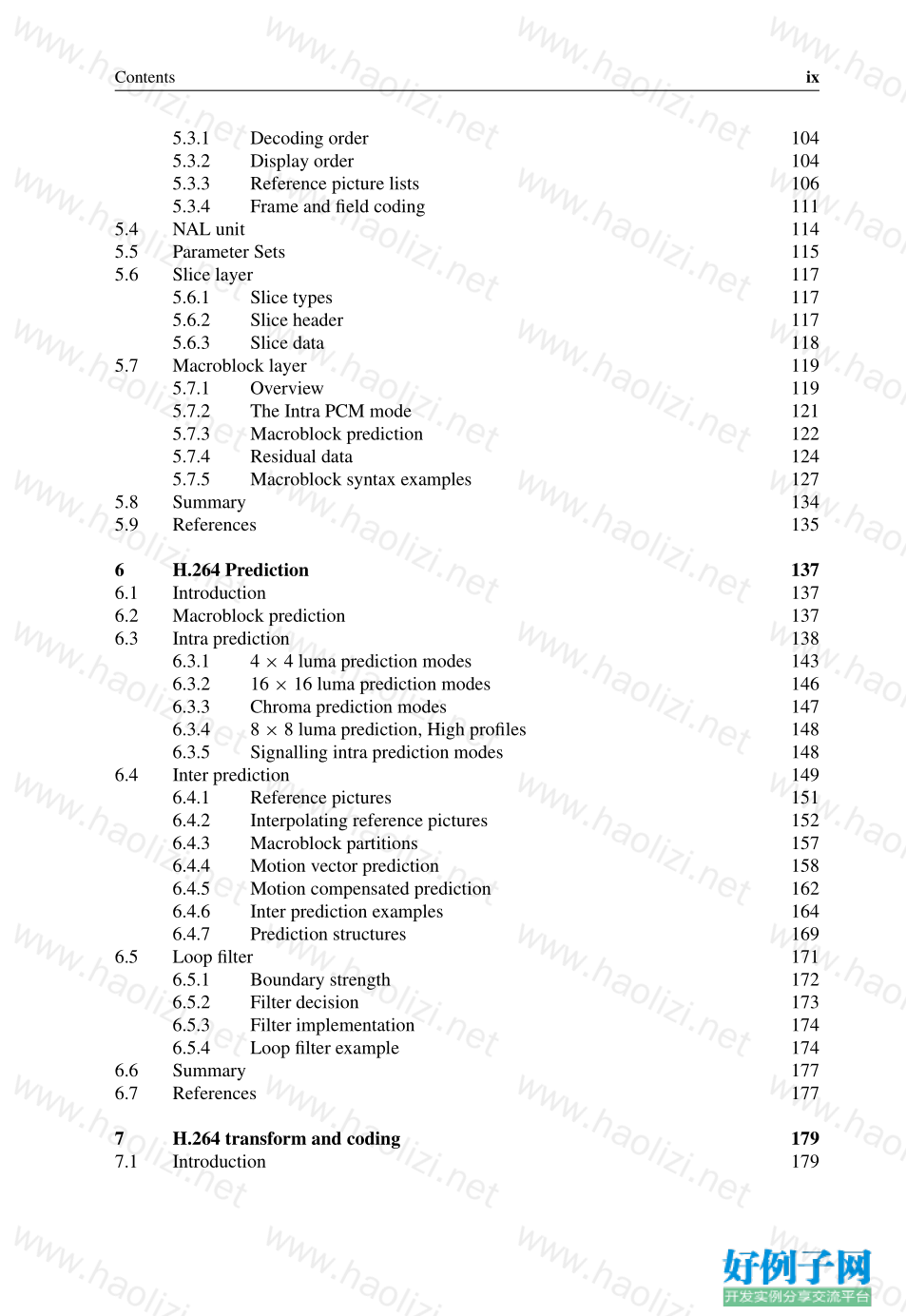
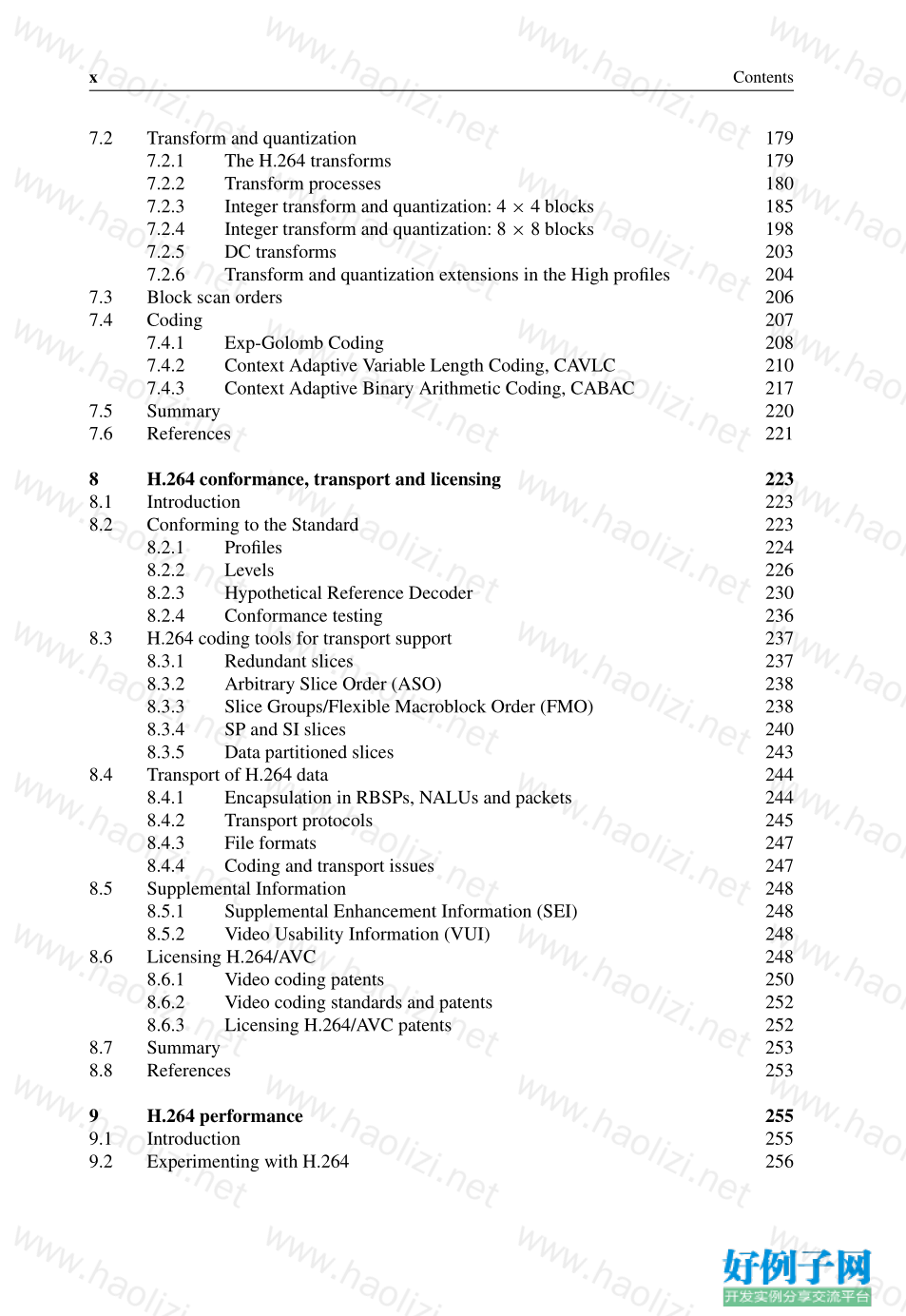
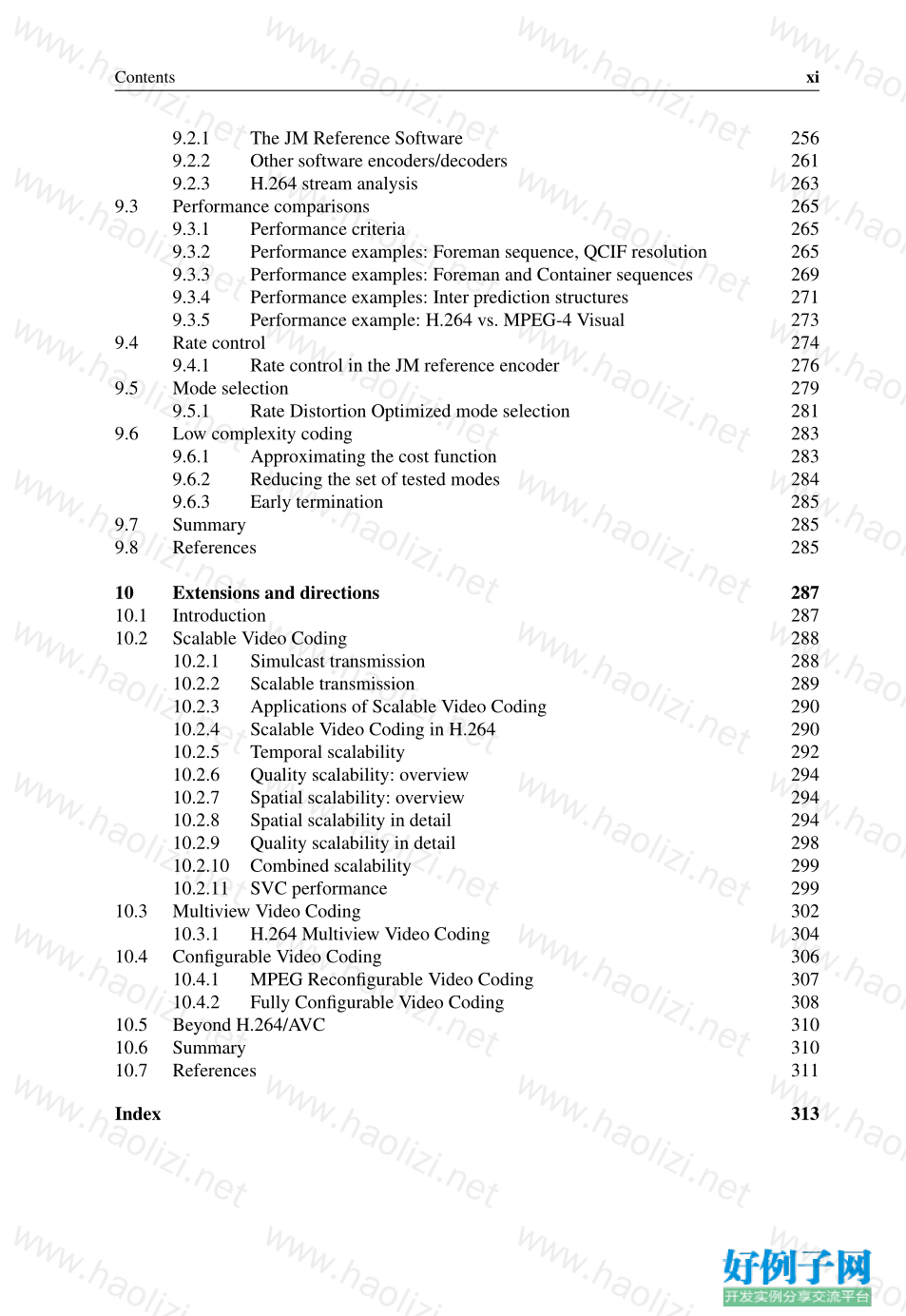



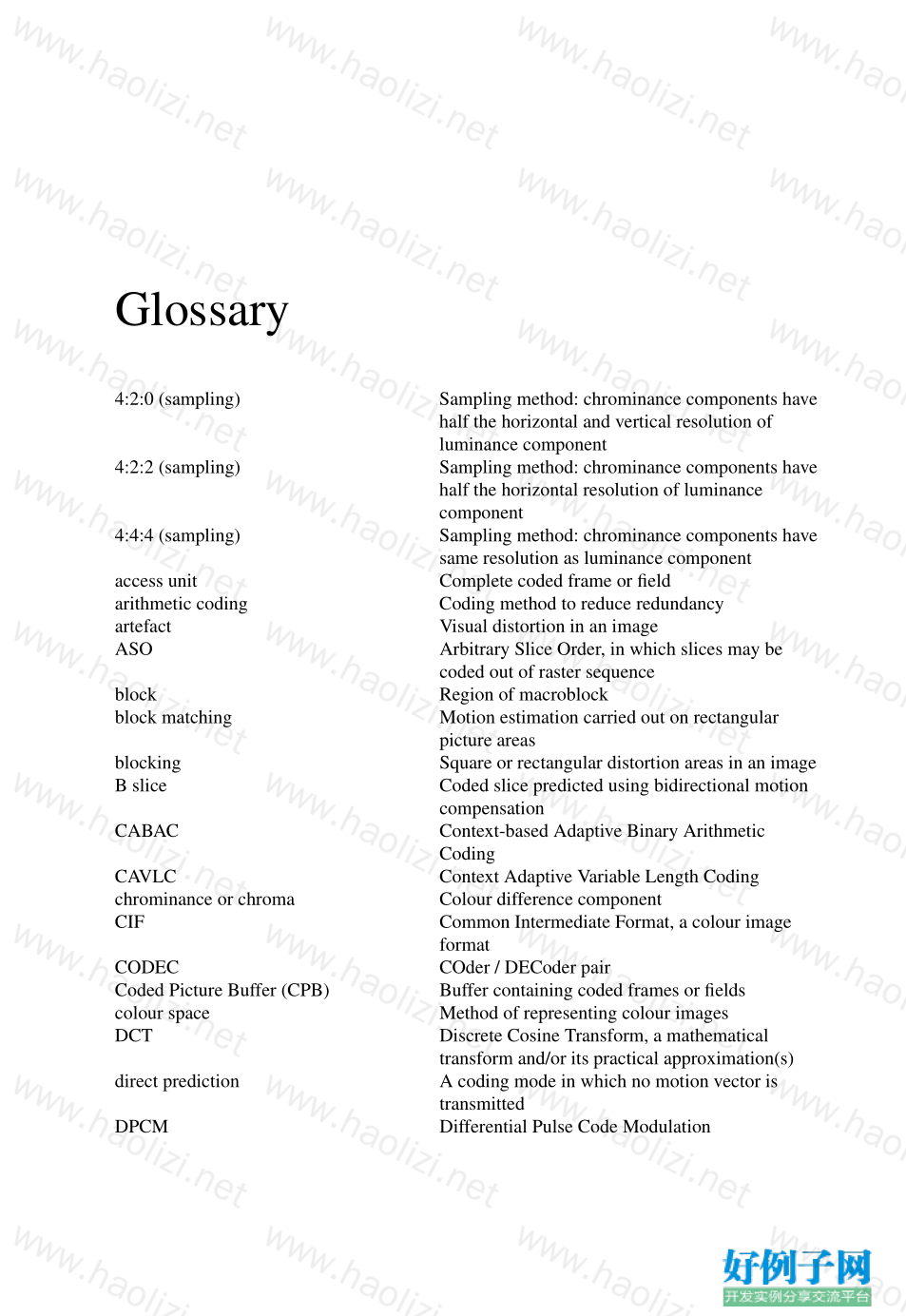
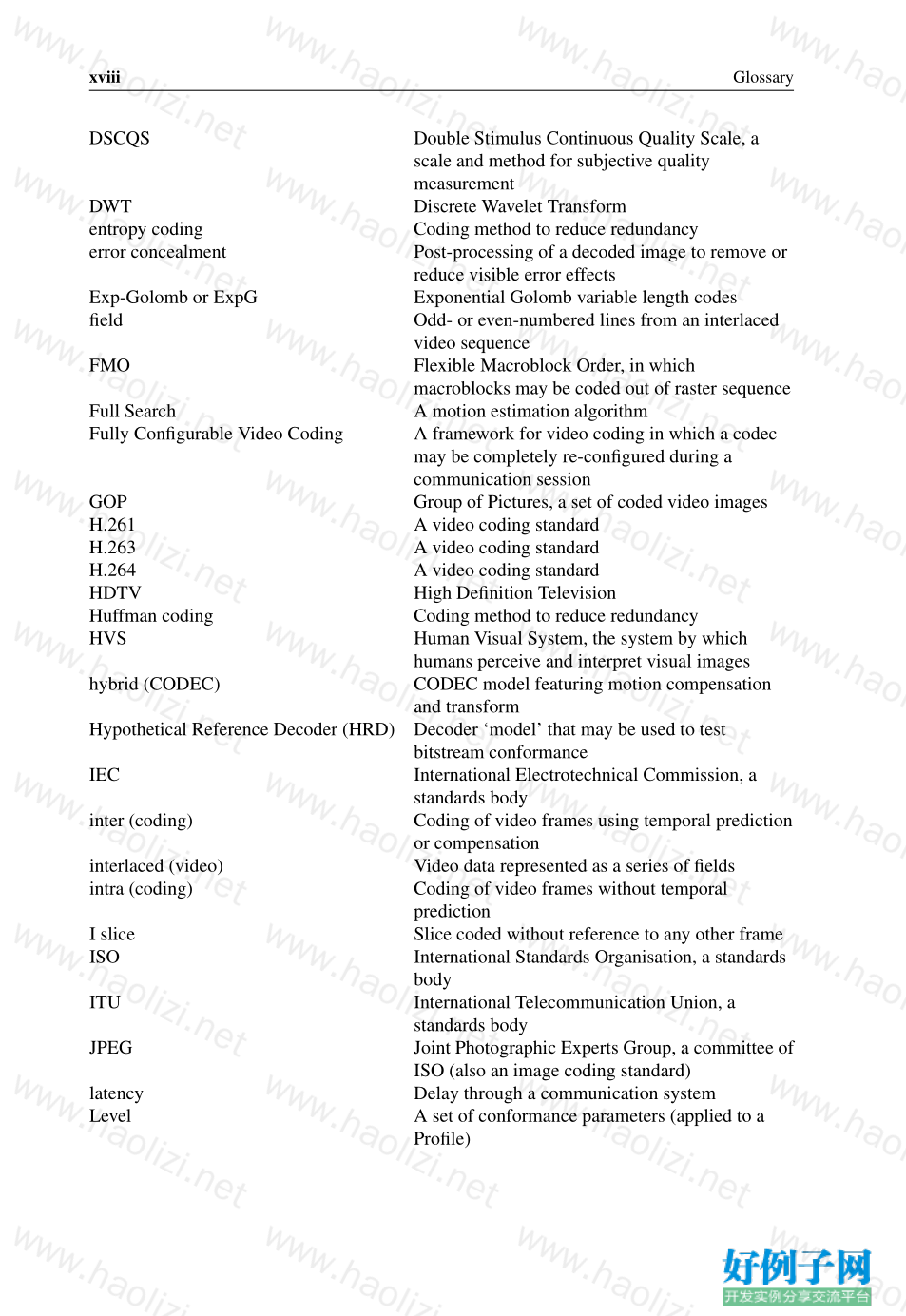
【核心代码】
Contents
About the Author xiii
Preface xv
Glossary xvii
List of Figures xxi
List of Tables xxix
1 Introduction 1
1.1 A change of scene 1
1.2 Driving the change 4
1.3 The role of standards 4
1.4 Why H.264 Advanced Video Coding is important 4
1.5 About this book 5
1.6 Reference 6
2 Video formats and quality 7
2.1 Introduction 7
2.2 Natural video scenes 7
2.3 Capture 8
2.3.1 Spatial sampling 9
2.3.2 Temporal sampling 9
2.3.3 Frames and fields 11
2.4 Colour spaces 12
2.4.1 RGB 12
2.4.2 YCrCb 13
2.4.3 YCrCb sampling formats 14
2.5 Video formats 16
2.5.1 Intermediate formats 16
2.5.2 Standard Definition 17
2.5.3 High Definition 18
2.6 Quality 19
2.6.1 Subjective quality measurement 20
2.6.2 Objective quality measurement 21
viii Contents
2.7 Summary 24
2.8 References 24
3 Video coding concepts 25
3.1 Introduction 25
3.2 Video CODEC 26
3.3 Prediction model 28
3.3.1 Temporal prediction 28
3.3.2 Spatial model: intra prediction 38
3.4 Image model 40
3.4.1 Predictive image coding 41
3.4.2 Transform coding 42
3.4.3 Quantization 50
3.4.4 Reordering and zero encoding 52
3.5 Entropy coder 57
3.5.1 Predictive coding 57
3.5.2 Variable-length coding 58
3.5.3 Arithmetic coding 65
3.6 The hybrid DPCM/DCT video CODEC model 68
3.7 Summary 79
3.8 References 79
4 What is H.264? 81
4.1 Introduction 81
4.2 What is H.264? 81
4.2.1 A video compression format 81
4.2.2 An industry standard 82
4.2.3 A toolkit for video compression 83
4.2.4 Better video compression 83
4.3 How does an H.264 codec work? 83
4.3.1 Encoder processes 85
4.3.2 Decoder processes 89
4.4 The H.264/AVC Standard 91
4.5 H.264 Profiles and Levels 92
4.6 The H.264 Syntax 94
4.7 H.264 in practice 97
4.7.1 Performance 97
4.7.2 Applications 98
4.8 Summary 98
4.9 References 98
5 H.264 syntax 99
5.1 Introduction 99
5.1.1 A note about syntax examples 99
5.2 H.264 syntax 100
5.3 Frames, fields and pictures 101
Contents ix
5.3.1 Decoding order 104
5.3.2 Display order 104
5.3.3 Reference picture lists 106
5.3.4 Frame and field coding 111
5.4 NAL unit 114
5.5 Parameter Sets 115
5.6 Slice layer 117
5.6.1 Slice types 117
5.6.2 Slice header 117
5.6.3 Slice data 118
5.7 Macroblock layer 119
5.7.1 Overview 119
5.7.2 The Intra PCM mode 121
5.7.3 Macroblock prediction 122
5.7.4 Residual data 124
5.7.5 Macroblock syntax examples 127
5.8 Summary 134
5.9 References 135
6 H.264 Prediction 137
6.1 Introduction 137
6.2 Macroblock prediction 137
6.3 Intra prediction 138
6.3.1 4 × 4 luma prediction modes 143
6.3.2 16 × 16 luma prediction modes 146
6.3.3 Chroma prediction modes 147
6.3.4 8 × 8 luma prediction, High profiles 148
6.3.5 Signalling intra prediction modes 148
6.4 Inter prediction 149
6.4.1 Reference pictures 151
6.4.2 Interpolating reference pictures 152
6.4.3 Macroblock partitions 157
6.4.4 Motion vector prediction 158
6.4.5 Motion compensated prediction 162
6.4.6 Inter prediction examples 164
6.4.7 Prediction structures 169
6.5 Loop filter 171
6.5.1 Boundary strength 172
6.5.2 Filter decision 173
6.5.3 Filter implementation 174
6.5.4 Loop filter example 174
6.6 Summary 177
6.7 References 177
7 H.264 transform and coding 179
7.1 Introduction 179
x Contents
7.2 Transform and quantization 179
7.2.1 The H.264 transforms 179
7.2.2 Transform processes 180
7.2.3 Integer transform and quantization: 4 × 4 blocks 185
7.2.4 Integer transform and quantization: 8 × 8 blocks 198
7.2.5 DC transforms 203
7.2.6 Transform and quantization extensions in the High profiles 204
7.3 Block scan orders 206
7.4 Coding 207
7.4.1 Exp-Golomb Coding 208
7.4.2 Context Adaptive Variable Length Coding, CAVLC 210
7.4.3 Context Adaptive Binary Arithmetic Coding, CABAC 217
7.5 Summary 220
7.6 References 221
8 H.264 conformance, transport and licensing 223
8.1 Introduction 223
8.2 Conforming to the Standard 223
8.2.1 Profiles 224
8.2.2 Levels 226
8.2.3 Hypothetical Reference Decoder 230
8.2.4 Conformance testing 236
8.3 H.264 coding tools for transport support 237
8.3.1 Redundant slices 237
8.3.2 Arbitrary Slice Order (ASO) 238
8.3.3 Slice Groups/Flexible Macroblock Order (FMO) 238
8.3.4 SP and SI slices 240
8.3.5 Data partitioned slices 243
8.4 Transport of H.264 data 244
8.4.1 Encapsulation in RBSPs, NALUs and packets 244
8.4.2 Transport protocols 245
8.4.3 File formats 247
8.4.4 Coding and transport issues 247
8.5 Supplemental Information 248
8.5.1 Supplemental Enhancement Information (SEI) 248
8.5.2 Video Usability Information (VUI) 248
8.6 Licensing H.264/AVC 248
8.6.1 Video coding patents 250
8.6.2 Video coding standards and patents 252
8.6.3 Licensing H.264/AVC patents 252
8.7 Summary 253
8.8 References 253
9 H.264 performance 255
9.1 Introduction 255
9.2 Experimenting with H.264 256
Contents xi
9.2.1 The JM Reference Software 256
9.2.2 Other software encoders/decoders 261
9.2.3 H.264 stream analysis 263
9.3 Performance comparisons 265
9.3.1 Performance criteria 265
9.3.2 Performance examples: Foreman sequence, QCIF resolution 265
9.3.3 Performance examples: Foreman and Container sequences 269
9.3.4 Performance examples: Inter prediction structures 271
9.3.5 Performance example: H.264 vs. MPEG-4 Visual 273
9.4 Rate control 274
9.4.1 Rate control in the JM reference encoder 276
9.5 Mode selection 279
9.5.1 Rate Distortion Optimized mode selection 281
9.6 Low complexity coding 283
9.6.1 Approximating the cost function 283
9.6.2 Reducing the set of tested modes 284
9.6.3 Early termination 285
9.7 Summary 285
9.8 References 285
10 Extensions and directions 287
10.1 Introduction 287
10.2 Scalable Video Coding 288
10.2.1 Simulcast transmission 288
10.2.2 Scalable transmission 289
10.2.3 Applications of Scalable Video Coding 290
10.2.4 Scalable Video Coding in H.264 290
10.2.5 Temporal scalability 292
10.2.6 Quality scalability: overview 294
10.2.7 Spatial scalability: overview 294
10.2.8 Spatial scalability in detail 294
10.2.9 Quality scalability in detail 298
10.2.10 Combined scalability 299
10.2.11 SVC performance 299
10.3 Multiview Video Coding 302
10.3.1 H.264 Multiview Video Coding 304
10.4 Configurable Video Coding 306
10.4.1 MPEG Reconfigurable Video Coding 307
10.4.2 Fully Configurable Video Coding 308
10.5 Beyond H.264/AVC 310
10.6 Summary 310
10.7 References 311
Index 313
小贴士
感谢您为本站写下的评论,您的评论对其它用户来说具有重要的参考价值,所以请认真填写。
- 类似“顶”、“沙发”之类没有营养的文字,对勤劳贡献的楼主来说是令人沮丧的反馈信息。
- 相信您也不想看到一排文字/表情墙,所以请不要反馈意义不大的重复字符,也请尽量不要纯表情的回复。
- 提问之前请再仔细看一遍楼主的说明,或许是您遗漏了。
- 请勿到处挖坑绊人、招贴广告。既占空间让人厌烦,又没人会搭理,于人于己都无利。
关于好例子网
本站旨在为广大IT学习爱好者提供一个非营利性互相学习交流分享平台。本站所有资源都可以被免费获取学习研究。本站资源来自网友分享,对搜索内容的合法性不具有预见性、识别性、控制性,仅供学习研究,请务必在下载后24小时内给予删除,不得用于其他任何用途,否则后果自负。基于互联网的特殊性,平台无法对用户传输的作品、信息、内容的权属或合法性、安全性、合规性、真实性、科学性、完整权、有效性等进行实质审查;无论平台是否已进行审查,用户均应自行承担因其传输的作品、信息、内容而可能或已经产生的侵权或权属纠纷等法律责任。本站所有资源不代表本站的观点或立场,基于网友分享,根据中国法律《信息网络传播权保护条例》第二十二与二十三条之规定,若资源存在侵权或相关问题请联系本站客服人员,点此联系我们。关于更多版权及免责申明参见 版权及免责申明



网友评论
我要评论